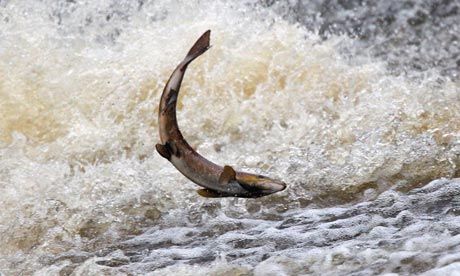
China's appetite for Scottish farmed salmon is threatening dwindling stocks of sea trout and wild salmon, according to conservationists.
A new trade agreement was signed last month with the Chinese vice-premier, Li Keqiang, by Scotland's first minister, Alex Salmond, who boasted that "even if 1% of the people of China decide to eat Scottish salmon, then we'll have to double production in Scotland".
But the prospect of a massive increase in farmed fish production has horrified defenders of Scotland's depleted indigenous wild salmon and sea trout runs.
Now Salmond has also been accused of laying the Scottish government open to the charge that it is in effect "supporting repression". China is halting the import of farmed salmon from Norway in retaliation for the Nobel peace prize being awarded to imprisoned Chinese dissident Liu Xiaobo. Not that it will make much difference: many of the larger farmed salmon enterprises in Scotland are Norwegian-owned.
The charges against the Scottish first minister have been made by Andrew Flitcroft, editor of Trout and Salmon magazine. "The implications of increasing significantly, let alone doubling, farmed salmon production in Scotland are simply terrifying," Flitcroft writes. "Surely it is recklessly irresponsible to contemplate any increase without first rectifying the dire existing problems."
Those problems are principally caused by sea lice, which are threatening to spiral out of control, destroying not just fish farm stocks but further damaging wild fish and the angling tourism industry of the western Highlands.
The size of the Chinese market for fresh Atlantic salmon is estimated at more than 10,000 tonnes a year, having grown considerably over the past decade. Scotland is the second largest salmon-producing country in the world, after Norway, and exports have grown by 500% in the past 20 years. Salmon now makes up 40% of Scottish food exports.
But can that success be sustained? The answer is no, according to Flitcroft. "Marine cages of hundreds of thousands of farmed salmon are breeding grounds for millions of sea lice; these parasites feed on the mucus, tissue and blood of their farmed salmon hosts. The companies employ a range of measures using highly toxic chemicals to combat the lice, in order to reduce the damage and stress caused to their captive hosts."
The young wild fish, known as smolts, which migrate from the rivers to the sea each spring, cannot cope with more than the odd louse yet now must run the gauntlet past the fish-farm cages on their migration routes. They are "ambushed" by the unnaturally high concentrations of lice. The attachment of more than 10 lice is almost invariably fatal. The fish are literally eaten alive, although death is usually hastened by secondary infections, which gain access through open wounds made by the grazing lice.
"This is the environmental calamity that the salmon farming industry and Scottish government is so determined to deny," says Flitcroft. "And make no mistake, there is no such thing as 'sustainable' farmed salmon, no matter what the evocative packaging on the supermarket shelves tries to convey."
Figures from the Scottish Environmental Protection Agency show that, over the past five years, fish farmers have used an increasing amount of veterinary chemicals - some rising by as much as 163% - designed to kill sea lice living on farmed fish. Over the same period, salmon production has grown by 11%.
Guy Linley-Adams, an environmental lawyer employed by the Salmon and Trout Association, said: "There are examples of farms that were unable to control their lice problem and as a result the fish were culled early."
But the Scottish government denies that there is a problem and said that the increasing use of sea lice medicines was "not in itself necessarily a matter for concern". This has prompted angling interests to make an official complaint to the European commission over what they claim is the Scottish government's failure to protect wild salmon.
The report by Linley-Adams, acting for the owners of the rights to Ullapool river in Wester Ross, details alleged government failures to designate an appropriate number of west coast Scottish rivers as special areas for conservation for the protection of wild Atlantic salmon under the European commission's habitats directive. The complaint also details the threats posed by salmon farming to two existing special areas: Little Gruinard, in north-west Ross-shire, and Loch Langavat on the Isle of Lewis.
Linley-Adams said: "The problems of the salmon farming industry are not new to anyone and have been known about for the best part of 20 years. The failure of the Scottish government to get to grips with the industry and ensure that it does not damage the wild Atlantic salmon and sea trout of the west coast and western isles is nothing short of a disgrace. European law requires member states to protect wild Atlantic salmon."
A Scottish government spokesman said: "These remarks are simply ill-informed, both about the situation in Scotland and about the relationship between Scotland and China.
"We have taken considerable steps to protect our wild salmon, with extensive investment to support conservation. Salmon stocks have stabilised following declines going back 50 years - well before fish farming became established in Scotland. Similar declines have been detected on both sides of the Atlantic.
"Scottish salmon farming is fully regulated and we have a framework in place to address fish health and minimise escapes, while developing better scientific understanding of interactions between farmed and wild fish. Thanks to these measures, escaped fish numbers are at an all-time low."



Reader Comments
to our Newsletter